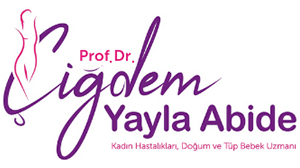Gynecology and Obstetrics Specialist Assoc. Prof. stated that the interest in ovarian freezing, which is performed to preserve fertility and increase the chance of healthy pregnancy at older ages, has increased. Dr. Çiğdem Yayla Abide says that ovarians collected before the age of 35 increase success. Abide states that women who plan to give birth for older ages should have their ovarian reserve checked regularly.
Every woman has the right to freezing
Ovarian freezing, which became widespread all over the world after the first live birth in 1986 and became one of the fertility preservation methods, has also been applied in Turkey since 2010. The scope of ovarian freezing, which could only be applied by cancer patients in the first years, was expanded with the regulation published in 2014 and offered the right to ovarian freezing to every woman, whether married or single, with low ovarian reserve. Underlining that there has been a great increase in ovarian freezing demands, especially in the last 5 years, Gynecology and Obstetrics Specialist Assoc. Dr. Çiğdem Yayla Abide says: “Today, women postpone their fertility due to reasons such as career planning, education, working life, searching for a suitable partner, not being ready for a second child, or health problems. During this process, ovarian quality decreases and chromosomal problems may occur in the ovarians. ovarian freezing is a practice we carry out at this point in order to preserve a woman's fertility and increase the chance of healthy pregnancy at older ages. There has been great interest in this subject, especially in the last 5 years. ovarian freezing can be performed for those who have not given birth yet, have low ovarian reserve, have a family history of early menopause, before chemotherapy, radiotherapy treatments and surgeries that will damage the ovarian reserve. "ovarian freezing is not applied to people who have no disease or a history of early menopause and have normal ovarian reserves."
It is better to do it before the age of 35
Stating that the chance of pregnancy in women is highest in the 25s, it decreases after the age of 30, and there is a significant decline after the age of 35. Abide recommends that the ovarian freezing process be performed before the age of 35: "Two important factors that determine the pregnancy rates after the ovarian freezing procedure; the woman's age at the time she froze her ovarians and the number of ovarians frozen. Freezing 8-10 ovarians under the age of 35 gives a 55-60 percent chance of pregnancy. If the ovarian reserve is low, this process must be done more than once. "For women over the age of 35, even if 8-10 ovarians are frozen, the chance of pregnancy does not exceed 30 percent."
Frozen ovarians can be stored for more than 5 years
Stating that the ovarian freezing process is performed similar to in vitro fertilization, Abide continues his words as follows: “First of all, we start hormone therapy to enlarge the ovarians, and we follow the follicles in the ovarians with ultrasound and hormones. When the ovarians reach 18-20 mm (usually takes 10-11 days), we mature the ovarians by giving a cracking injection, and after 34-36 hours, we collect the ovarians with the OPU process and deliver them to embryologists. “The collected mature ovarians are frozen by the rapid freezing method called vitrification and are stored in storage tanks containing liquid nitrogen at -196 degrees.”
Underlining that storage conditions are very important, Abide added that it is necessary to ensure that reliable embryology laboratories are preferred. Stating that frozen ovarians can be stored for 5 years and can be stored for a longer time with the permission of the Ministry of Health, Abide said, “The storage period, which can be extended up to 5 years every year with the approval of the patient, can be extended further with a petition to be submitted to the Ministry of Health after 5 years. In this way, ovarians can be thawed and used even after 10 years. "When the approval and petition period is delayed, the ovarians can be destroyed by the decision of the committee," he said.
Stating that the time between freezing the ovarians and thawing them does not affect the success, Abide stated that it is seen in the literature that live birth can occur even after 15-30 years of thawing.
The process is stopped in case of Covid diagnosis
If the patient is diagnosed with Covid during the ovarian freezing process, the treatment is interrupted. Health problems that may arise during this process, such as flu infection, may also postpone the treatment. ovarian freezing can be performed quickly, without waiting, for patients who have not yet started treatment after being diagnosed with cancer. Stating that cancer patients can undergo ovarian freezing procedures in a short time, Abide stated that anti-estrogen drugs are added to the treatment of breast cancer patients, thus reducing the risk of increased estrogen hormone.
Should ovarians or embryos be frozen?
Making a statement on the question 'Should ovarians or embryos be frozen?', which is one of the questions frequently asked by married patients before the freezing process, Abide said: "If embryo freezing was performed and the couples divorced, the embryos must be destroyed,
these embryos can no longer be used. For this reason, our married patients who do not want to take risks prefer the option of ovarian freezing.”
Referring to the success rate of in vitro fertilization treatments with collected fresh ovarians or frozen ovarians, Abide said, “This issue is among the questions that many of our patients have. ovarian freezing means temporarily stopping the metabolism of the ovarian cell. With the vitrification method, the formation of ice crystals is prevented and ovarian cells are stored for years without dying. "According to many studies, it is possible to say that the success rate is the same."







